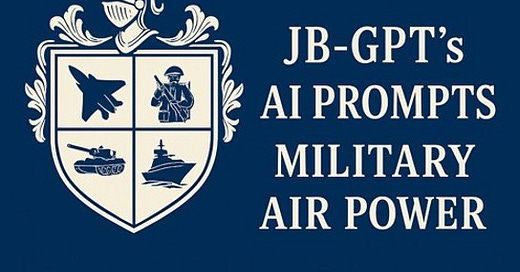2025-0208 AIR POWER 00—JB-GPT's LINKS: AI PROMPTS AIR POWER COMPLETE COURSE 1903 - 2025.
How technological advancements are reshaping unmanned aerial combat systems
LINK TO: JB-GPT’s AI PROMPTS MILITARY HISTORY WEB PAGE.
COMMENTS/CONTACT: zzzz707@live.com.au
PROMPT BASED AIR POWER COURSE HAS NOW BEEN COMPLETED.
These are the instructions which each prompt will provide to the AI of your choice:
Use this AI prompt to answer the above question(s).
You may use general knowledge only if it is directly supported by references from:
https://www.jb-gpt-prompts.com/jb-gpts-military-referencesPlus any bibliography or endnotes included below in this prompt.
Do not cite or infer from any unlisted source.
Use only material explicitly included in the approved references.
Your output must include:
Five to ten key points, each in its own paragraph.
Each key point must be supported by a specific reference, including book title and chapter number.
A full Harvard-style bibliography at the end of your response.
Each bibliography entry must appear in a separate paragraph and follow consistent formatting.
Do not include summaries, definitions, or commentary beyond these instructions. Just answer the questions as instructed.
AIR POWER NOTES (Please read before working through the Air Power Prompts
AIR POWER PROMPTS
20. 1942: DOOLITTLE RAID DEMONSTRATED LONG-RANGE STRIKE FROM CARRIERS
24. 1943: Combined Bomber Offensive coordinated RAF night raids & USAAF daylight precision bombing.
25. 1943: Aircraft like the Avro Lancaster enabled massed night bombing over Germany.
27. 1944: D-Day succeeded in part due to overwhelming Allied air superiority.
28. 1944: The P-51 Mustang enabled deep-penetration bomber raids over Germany.
29. 1944: The U.S. experience with close air support during WWII evolved......
30. 1945: Kamikaze pilots reflected Japan’s use of suicide tactics as airborne guided weapons.
31. 1945: Air power was decisive to victory in both European and Pacific theatres of WWII.
32. 1945: Firebombing of Tokyo demonstrates conventional air power's mass destruction capacity.
33. 1945: Carrier air power dominates in Pacific—Midway to Tokyo Bay.
34. 1945: Nuclear-capable bombers changed strategic doctrine at the end of WWII.
36. 1940s Mass Production enabled the Allies to gain Air Superiority and Strategic Mobility
37. 1944-45 Jet & Rocket Programs Failed to Save Nazi Germany from Allied Air Power.
38. 1948: The Berlin Airlift proved air logistics could defeat a siege.
39. 1952: The B-52 became a pillar of Cold War deterrence through nuclear readiness.
40.1950–1953: Air Power in Mountain Warfare During The Korean War.
41. 1950s–1970s: RAF & RAAF Doctrine in Cold War focused on Strategic Continuity.
42. 1960s F-4 Phantom & the multi-role millitary jet revolution.
43. 1965–1973: The Vietnam War Exposed the Limits of Strategic Bombing.
44. 1967–1973: The Failure of Arab Air Forces stemmed from a number of reasons such as poor training.
46. 1973:Yom Kippur War and SAMs exposed Israel's Doctrine as being based on false assumptions.
47. 1982: Falklands air war proves value of Sea Harrier & limited but decisive carrier operations.
48.1970s–1980s: NATO Doctrine Combined Deep Strikes withe Mobile Ground Operations.
49. 1980s: Stealth aircraft like the F-117 shifted strategic thinking on surprise and survivability.
50. 1980s: Cold War reconnaissance included high-altitude planes like the SR-71 and satellite ISR.
51. 1980s–1990s: NATO’s air power evolved from Cold War deterrence to expeditionary precision strike
52: 1980s–1990s: Red Flag and the Evolution of USAF Combat Readiness
53. Boyd’s OODA Loop Redefined Air Campaign Agility In The 1970–80s.
54: 1990s: Systemic Targeting Transformed U.S. Air Campaign Planning (Warden)
55: 1991: The Gulf War Demonstrated the Effectiveness of Precision-Guided Munitions
57: 1990s–2000s: Attack Helicopters Like the AH-64 Became Key Assets in Close Air Support
59: 2000s: UAVs Revolutionised Reconnaissance and Strike Operations Post-2000
60: 2000s: Network-Centric Warfare Allows Real-Time Data Sharing and Joint Strike Coordination
63. 2000s: Australia’s air doctrine emphasises regional readiness and coalition interoperability.
64. 2000s: Air logistics has been central to strategic reach from Berlin to Afghanistan.
65. 2000s: Global air mobility depends on aerial tankers and heavy lift aircraft.
66. 2000s: ISR platforms now include satellites, drones, and manned aircraft.
67. 2000s: Electronic warfare and cyber tools are core components of air operations.
68. 2000s: Asymmetric wars have forced Western air forces to adapt tactics and roles.
73. Modern Era: Multinational exercises like Red Flag standardise coalition air procedures.
74. Modern Era: Air power supports a wide range of operations, including humanitarian efforts.
75. Modern Era: Agility enables quick adaptation to operational environment changes.
76. Modern Era: Resilience enhances air power’s ability to withstand and recover from adversity.
77. Modern Era: Payload determines the range of effects air power can achieve.
78. Modern Era: Human and ethical considerations shape how air power is applied and perceived.




